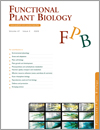
Functional Plant Biology
Volume 47 Number 2 2020
Knowledge about water relations of crops is critical for sustaining productivity and irrigation scheduling. Here, the coordination between embolism and leaf gas exchanged was measured for cotton plants, and results show that the hydraulic integrity of stem and roots was prioritised over canopy carbon gain during drought stress. These results demonstrate the hydraulic strategy of this important crop species, and suggest that irrigation should be applied shortly following stomatal closure to ensure canopy photosynthesis during and after water deficit.
Precise physiological assessments provide information about the extent of genetic variability, which helps in effective breeding programs. In the present study we compared the effects of different abiotic stress (drought, salinity and submergence) on growth, photosynthesis and antioxidant defence in three rice landraces to evaluate their performance under multiple abiotic stresses and possible opportunity of using in pre-breeding programs against drought, salinity and submergence, which show the adaptive fitness of genotype.
FP19032Low root PIP1-1 and PIP2 aquaporins expression could be related to reduced hydration in ‘Rangpur’ lime plants exposed to aluminium
Aluminium (Al) is toxic to most plants, including ‘Rangpur’ lime plants, which is an important rootstock for Citrus industry. Al is believed to cause inhibition of root growth leading to low gas exchange in leaves. Here we found Al-induced decrease in gene expression of water channels in plasma membrane responsible for water transport, called aquaporins. This opens a different interpretation for Al toxicity symptoms in plants exposed to Al.
FP19220The effect of zinc fertilisation and arbuscular mycorrhizal fungi on grain quality and yield of contrasting barley cultivars
 , Shi Fang Khor, Kylie Neumann, Rachel A. Burton and Stephanie J. Watts-Williams
, Shi Fang Khor, Kylie Neumann, Rachel A. Burton and Stephanie J. Watts-Williams 
Mycorrhizal fungi can improve the yield and nutrition of important agricultural crops including barley, but it is unknown whether they affect other aspects of grain quality. This study addresses whether soil zinc fertilisation (directly) and mycorrhizal fungi (indirectly) affect the grain quality of contrasting malting barley cultivars. The results of the study suggest that barley cultivar choice and, to a lesser extent, zinc fertilisation, are determinants of grain quality; mycorrhizal fungi affect some quality traits such as starch, but not others.
This work focused on understanding how nitrogen availability influenced plant growth in past environments when atmospheric CO2 concentrations were lower than modern values. We found that nitrogen availability can alter how stomatal and photosynthetic traits, and N-isotope discrimination are affected by growth at low CO2. Such effects may confound interpretations of plant responses to past low CO2 environments as well as the use of nitrogen isotopes as paleo-indicators.
FP19054Mechanistic understanding of iron toxicity tolerance in contrasting rice varieties from Africa: 2. Root oxidation ability and oxidative stress control
 , Fredrickson Entila, James Egdane, Myrish Pacleb, Meggy Lou Katimbang, Mathew M. Dida, Abdelbagi M. Ismail and Khady N. Drame
, Fredrickson Entila, James Egdane, Myrish Pacleb, Meggy Lou Katimbang, Mathew M. Dida, Abdelbagi M. Ismail and Khady N. Drame
Excessive iron concentrations can cause toxicity in rice plants, and dramatically reduce its performance. A good understanding of the mechanisms used by rice to withstand the high iron in its environment can help improve rice tolerance to iron toxicity. We report key traits associated with these tolerance mechanisms such as well-developed aerenchyma, radial oxygen loss restricted to the root cap as well as strong activation of anti-oxidative enzymes.
FP19054 Abstract | FP19054 Full Text | FP19054PDF (1.6 MB) Open Access Article
It is currently unclear whether treating with a precursor and spraying of exogenous hormones can influence the cuticular wax of pear fruits. The wax profiles of palmitic acid, hexacosanoic acid-, ethephon- and methyl jasmonate-treated fruits of three pear cultivars were analysed by GC-MS and FESEM. Results showed that the different treatments induced various changes in the cuticular wax of the three pear cultivars.
Reproductive growth is very important for plant survival and population establishment under saline conditions. The mechanisms underlying the effect of salinity on plant reproduction remains unknown. NaCl markedly increased the GA3, GA4, IAA and ZR contents in flowers with the co-ordinated upregulation of gene expressional level involving in phytohormone biosynthesis and signal transduction. Unravelling the mechanism of plant salt tolerance during the reproductive growth will be helpful for improving agricultural production.




